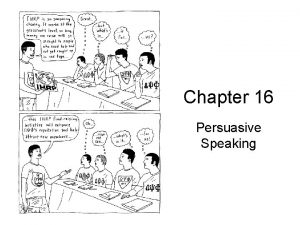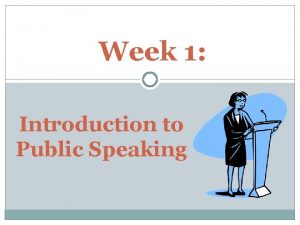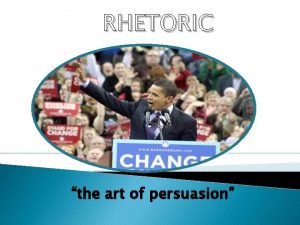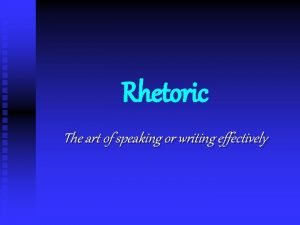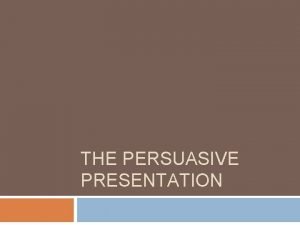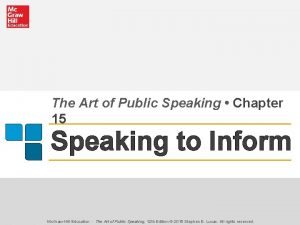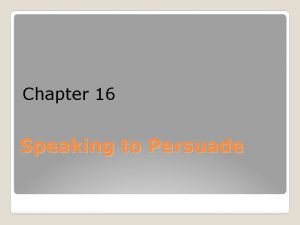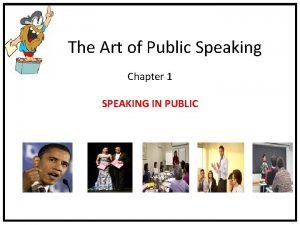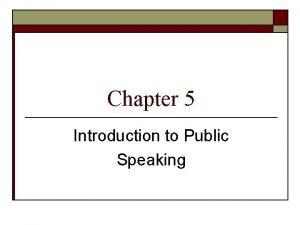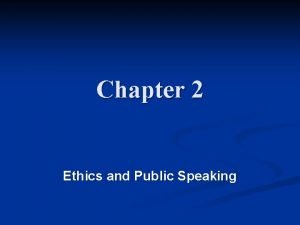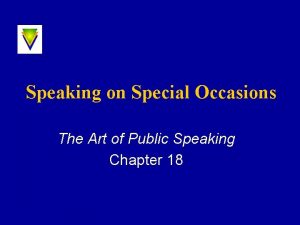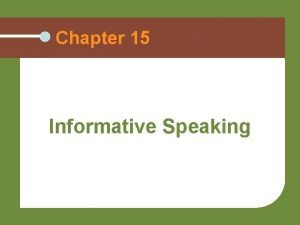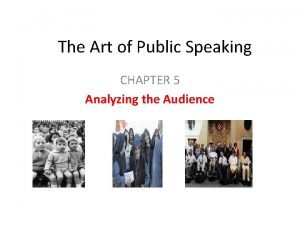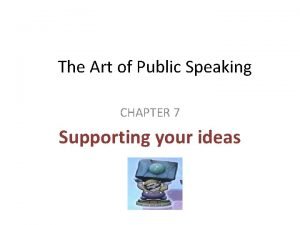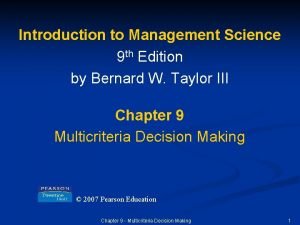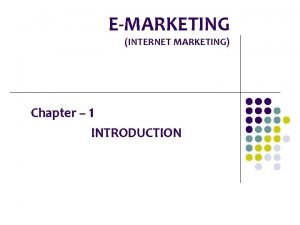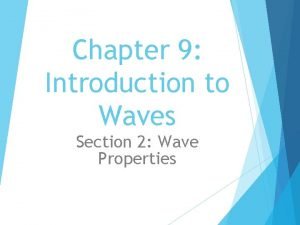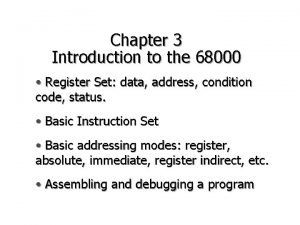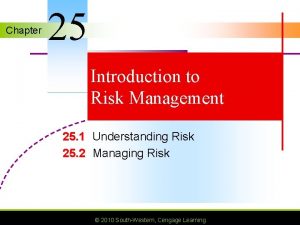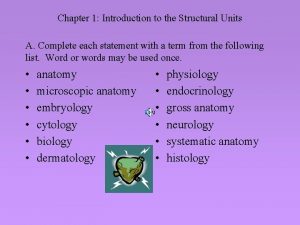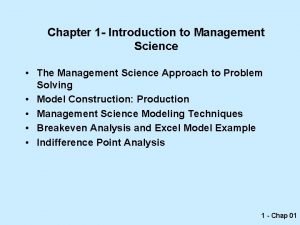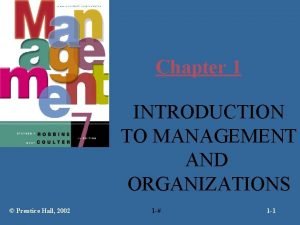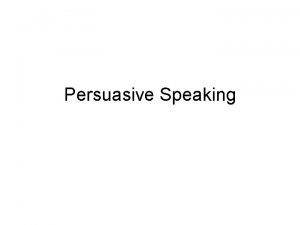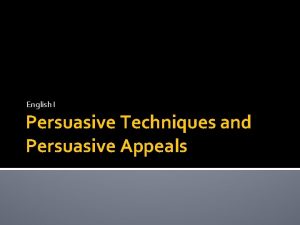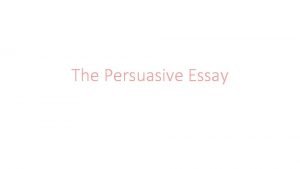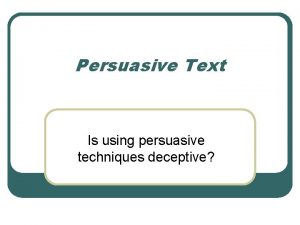Chapter 16 Persuasive Speaking Persuasive Speaking Introduction A




































- Slides: 36

Chapter 16 Persuasive Speaking

Persuasive Speaking: Introduction • A speech can be well organized, with solid supporting materials, and still fail to persuade. • This chapter will explore how to motivate an audience to take a specific action or adopt certain ideas, values, or beliefs.

Persuasive Speaking: An Overview • This chapter will cover: – The nature of a persuasive speech – Framing your argument based on audience analysis – Ethical obligations – Organizing your persuasive speech

The Nature of a Persuasive Speech: Persuasive Speeches Attempt to Influence Audience Members • The goal is to influence your audience’s beliefs, attitudes, or actions. • Speakers try to do one or more of the following: – Strengthen audience commitment – Weaken audience commitment – Advocate audience action

The Nature of a Persuasive Speech: Persuasive Speeches Attempt to Influence Audience Members

The Nature of a Persuasive Speech: Persuasive Speeches Advocate fact, Value, or Policy Claims • A persuasive speech makes one of three types of claims: – Fact claim: Asserts that something is true or false – Value claim: Offers a judgment on a subject – Policy claim: Advocates an action by organizations, institutions, or audience members

The Nature of a Persuasive Speech: Persuasive Speeches Use Strategic Discourse • Select arguments with the best chance of achieving your rhetorical purpose in an ethical way. • You must understand your audience’s perspective on your topic to choose arguments wisely.

The Nature of a Persuasive Speech: Strategic Discourse

Framing Your Argument Based on Audience Disposition

Framing Your Argument Based on Audience Disposition • Consider your audience’s: – Latitude of acceptance (range of acceptable positions) – Latitude of rejection (range of unacceptable positions)

Framing Your Argument Based on Audience Disposition • Boomerang effect: Pushing listeners to oppose your ideas even more vigorously • This happens when your position falls within your listeners’ latitude of rejection and they have a strong and very different viewpoint from yours.

Framing Your Argument Based on Audience Disposition

Tailoring Your Persuasive Message to Your Audience • Appealing to your audience’s needs • Maslow’s hierarchy of needs: Basic-level needs must be met before higher-level needs become important.

Tailoring Your Persuasive Message to Your Audience • If you can relate your message to your listeners’ various needs, you are more likely to persuade them.

Tailoring Your Persuasive Message to Your Audience: Connecting to Your Listeners’ Values • Values: Core conceptions of what is desirable for your life and society • Values guide judgments • Explain how your argument aligns with audience values

Connecting to Your Listeners’ Values

Tailoring Your Persuasive Message to Your Audience: Demonstrating How Your Audience Benefits • Help listeners visualize benefits gained if they take the actions you are advocating. • Listeners weigh costs and benefits before responding to your persuasive appeal. – Tip: Show costs are low.

Demonstrating How Your Audience Benefits

Tailoring Your Persuasive Message to Your Audience: Acknowledging Listeners’ Reservations • Use a two-sided argument in which you voice your listeners’ objections to your thesis. • Then refute or mitigate these objections with evidence and sound reasoning.

Acknowledging Listeners’ Reservations

Tailoring Your Persuasive Message to Your Audience: Focusing on Peripheral Beliefs • Peripheral beliefs: Beliefs that have not been held for a long time • Core beliefs: Beliefs held for a long time that are relatively immune to persuasion

Ethical Persuasion: Help Your Audience Make an Informed Decision • Present truthful claims and key facts to help your listeners accept your thesis. • Do not manipulate listeners into agreement. • Avoid arguments based on faulty reasoning.

Ethical Persuasion: Research Your Facts • Ensure that facts are accurate before presenting them. • If few credible sources support your claim, research other arguments that support your position.

Ethical Persuasion: Note Any Biases • Make listeners aware of any rewards that may come to you if they accept your thesis. • Your audience will respect your honesty when you reveal any biases. • Practice full disclosure.

Ethical Persuasion: Attribute Your Research Properly • Cite your sources. • Ensure that quotations and paraphrases are accurate.

Organizing Your Persuasive Speech: Organizing Fact Claims • Use a causal pattern when you want to argue that one thing causes another. • Example: – Thesis: Fast-food restaurants are a significant cause of health problems in the United States.

Organizing Your Persuasive Speech: Organizing Fact Claims • Use a comparison pattern when you want to claim that two things are similar or different. • Example: – Thesis: There are significant differences between the two candidates for the legislature in our district.

Organizing Your Persuasive Speech: Organizing Fact Claims • Use a categorical pattern when each main point reflects a different reason that you believe your fact claim is true. • Example: – Thesis: The earth is experiencing climate change.

Organizing Your Persuasive Speech: Organizing Value Claims • Use a criteria-application pattern when one point establishes standards for the value judgment you make and the next point applies it to your thesis. • Example: – Thesis: Community service is a valuable part of the college experience.

Organizing Your Persuasive Speech: Organizing Value Claims • Use a categorical pattern when listeners understand each point’s relevance to the claim, making it unnecessary for you to explain how each main point supports your value judgment. • Example: – Thesis: Advanced driver-training courses are beneficial.

Organizing Your Persuasive Speech: Organizing Policy Claims • Use a motivated sequence to establish five main points: – Attention – Need – Satisfaction – Visualization – Action

Organizing Your Persuasive Speech: Policy Claims

Organizing Your Persuasive Speech: Organizing Policy Claims • Use a problem-causesolution pattern that consists of the following three points: – Present the problem. – Demonstrate how the existing organizational or institutional policies will not solve it. – Present a solution to minimize the problem.

Organizing Your Persuasive Speech: Organizing Policy Claims • Use a comparative advantage format to persuade listeners that your proposal is better than the status quo, although a policy change may not be urgent. – The first point on your outline reveals your solution. – Each subsequent point details an advantage of your solution.

Organizing Policy Claims: Comparative Advantage Format

Tips for Organizing Your Persuasive Speech • Tip: It is easiest to motivate your audience to action when you know that they already agree with your claims. • Tip: Persuasion works best when you tailor your message to the audience, so be sure you know what your audience’s needs, motivations, and values are as they relate to your topic.
 Chapter 16 persuasive speaking
Chapter 16 persuasive speaking Introduction to public speaking chapter 1
Introduction to public speaking chapter 1 Rhetoric: the art of persuasive writing and public speaking
Rhetoric: the art of persuasive writing and public speaking The art of speaking or writing effectively is called
The art of speaking or writing effectively is called What is powerpoint presentation
What is powerpoint presentation Definition of persuasive speech
Definition of persuasive speech The art of public speaking chapter 15
The art of public speaking chapter 15 Chapter 16 speaking to persuade
Chapter 16 speaking to persuade Chapter 1 speaking in public
Chapter 1 speaking in public Public speaking chapter 5
Public speaking chapter 5 Incremental plagiarism
Incremental plagiarism Public speaking chapter 1
Public speaking chapter 1 The art of public speaking chapter 18
The art of public speaking chapter 18 Some important kinds of mathematical statements
Some important kinds of mathematical statements The art of public speaking chapter 15
The art of public speaking chapter 15 The art of public speaking chapter 5
The art of public speaking chapter 5 Glossophobia statistics
Glossophobia statistics Intro paragraph outline
Intro paragraph outline Levels of ecological organization
Levels of ecological organization Introduction to operations management chapter 1
Introduction to operations management chapter 1 Introduction to management science solution
Introduction to management science solution Chapter 52 an introduction to ecology and the biosphere
Chapter 52 an introduction to ecology and the biosphere E-marketing concept
E-marketing concept Chapter 9 review introduction to stoichiometry
Chapter 9 review introduction to stoichiometry Chapter 9 introduction to waves
Chapter 9 introduction to waves Chaparral climograph
Chaparral climograph 3 components of research
3 components of research Motorola 68000 isa
Motorola 68000 isa Pure risk examples
Pure risk examples Chapter 24 section 1 animal characteristics
Chapter 24 section 1 animal characteristics Chapter 21 introduction to risk management
Chapter 21 introduction to risk management Section 1 introduction to protists answer key
Section 1 introduction to protists answer key Introduction to the structural units chapter 1 answers
Introduction to the structural units chapter 1 answers Medical terminology chapter 1 answer key
Medical terminology chapter 1 answer key Introduction to management science chapter 1 solutions
Introduction to management science chapter 1 solutions Introduction to management and organization
Introduction to management and organization Human resource management chapter 1
Human resource management chapter 1
